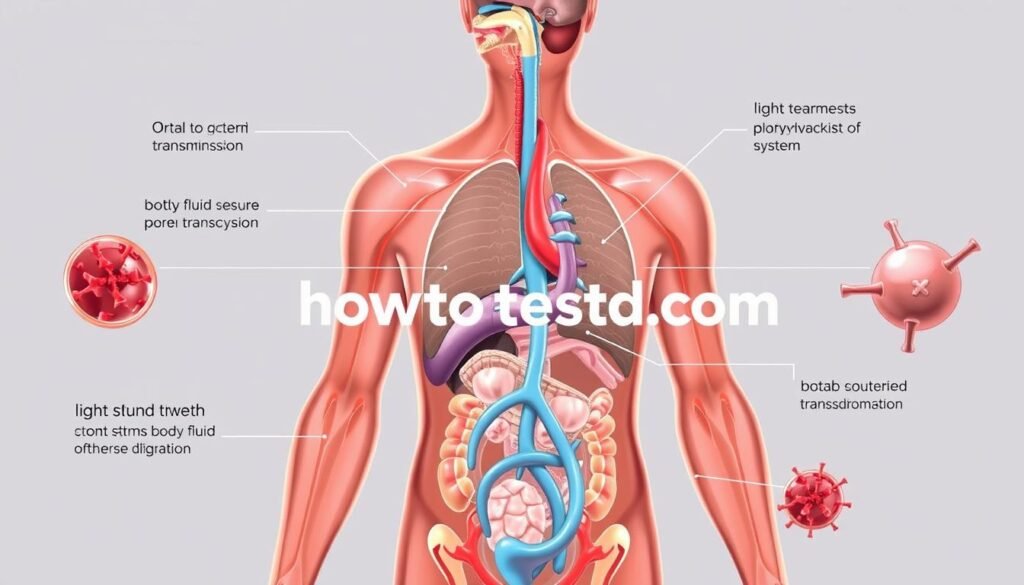STDs Explained: Learn About Sexually Transmitted Diseases
Nearly 20 million new cases of sexually transmitted diseases (STDs) are reported every year in the United States. This is according to the Centers for Disease Control and Prevention (CDC). It shows how important it is to know about STDs and the risks they bring.
STDs spread mainly through sex. They can be caused by bacteria, viruses, or parasites. It’s key to take care of your health. Knowing the basics of STDs is a good start.
It’s important to be proactive about your health. Don’t wait to get tested. Learning about STDs helps you make smart choices for your health.
Key Takeaways
- STDs are a big public health issue in the United States.
- Knowing what STDs are and why they happen is key to staying safe.
- Getting tested is a big step in keeping your sex life healthy.
- STDs can be caused by bacteria, viruses, or parasites.
- Being proactive about your health can stop serious problems later.
What is a STD: Definition and Basic Understanding
First, let’s talk about what STDs are. Sexually transmitted diseases (STDs) are infections spread through sex. This includes vaginal, anal, or oral sex. They can be caused by bacteria, viruses, or parasites.
STDs can cause symptoms like discharge, sores, or pain when you pee. But, some STDs don’t show symptoms at all. It’s very important to get tested often, if you have sex with many people.
Medical Definition of Sexually Transmitted Diseases
STDs are infections mainly spread through sex. This includes chlamydia, gonorrhea, syphilis, HIV, herpes, HPV, and hepatitis B and C. The Centers for Disease Control and Prevention (CDC) gives info on how to diagnose, treat, and prevent these diseases.
How STDs Differ from Other Infections
STDs are different because they spread through sex. They don’t spread like airborne pathogens or through food and water. Knowing this helps us prevent and treat STDs better.
| STD Type | Cause | Common Symptoms |
|---|---|---|
| Chlamydia | Bacterial | Abnormal discharge, pain while urinating |
| Gonorrhea | Bacterial | Thick, cloudy discharge, pain while urinating |
| Herpes | Viral | Painful sores or blisters |
Knowing the basics of STDs is key for prevention and treatment. By understanding what STDs are, how they spread, and their symptoms, we can protect ourselves and our partners.
The Most Common Types of STDs
It’s important to know about common STDs to prevent and catch them early. STDs fall into three main groups: bacterial, viral, and parasitic.
Bacterial STDs: Chlamydia, Gonorrhea, Syphilis
Bacterial STDs come from bacteria and can be treated with antibiotics. Chlamydia is very common and often doesn’t show symptoms. But, it can cause big problems if not treated.
Gonorrhea is another common bacterial STD. It can infect the genitals, rectum, and throat. Syphilis is very contagious and gets worse if not treated.
- Chlamydia: Often doesn’t show symptoms, but can cause big problems.
- Gonorrhea: Can infect genitals, rectum, and throat.
- Syphilis: Gets worse if not treated, very contagious.
Viral STDs: HIV, Herpes, HPV, Hepatitis
Viral STDs are caused by viruses and can harm your health a lot. HIV attacks your immune system. Herpes causes sores that come and go.
HPV can cause cervical and genital cancers. Hepatitis makes your liver inflamed and can cause serious problems.
- HIV: Attacks the immune system.
- Herpes: Causes outbreaks of sores.
- HPV: Can lead to cervical and genital cancers.
- Hepatitis: Causes liver inflammation.
Parasitic and Other STDs
Parasitic STDs, like trichomoniasis, are caused by parasites. They can be treated with special medicines.
Recognizing STD Symptoms
Knowing the signs of STDs is important. They can show as sores, discharge, painful urination, or unusual bleeding. Spotting these early helps a lot with treatment.
Common Warning Signs in Men
Men might feel pain when they pee, have odd discharge, or swollen testicles. Genital herpes can cause sores or blisters. It’s key for men to watch for these signs and get help fast.
Common Warning Signs in Women
Women might notice odd discharge, pain during sex, or bleeding between periods. Untreated STDs like chlamydia or gonorrhea can cause serious problems. Spotting these signs early can stop big health issues later.
Asymptomatic STDs: The Silent Threat
Some STDs don’t show symptoms. This makes them very dangerous because people can spread them without knowing. Getting tested often is key to catching these silent STDs and stopping them from spreading.
| Symptom | Men | Women |
|---|---|---|
| Painful Urination | Common | Less Common |
| Unusual Discharge | Common | Common |
| Pain During Sex | Rare | Common |
Knowing and spotting STD symptoms is a big step in fighting these infections. By knowing the signs and getting tested often, people can keep their sexual health safe.
How STDs Are Transmitted
It’s important to know how STDs spread. STDs, or sexually transmitted diseases, mainly go from person to person through sex. But, they can also spread in other ways.
Sexual Transmission Routes
Sex is the main way STDs are passed on. This includes sex in the vagina, anus, and mouth. Sexual contact lets germs move from one person to another. For example, chlamydia, gonorrhea, and syphilis often spread through sex. Safe sex practices help stop these diseases.
“The risk of getting an STD is directly related to the number of sexual partners one has,” health experts say. Having fewer partners or being monogamous can lower the risk a lot.
Non-Sexual Transmission Possibilities
Even though rare, STDs can spread in ways not related to sex. Some diseases can pass from mother to child during pregnancy or birth. Maternal transmission is a big worry for HIV and syphilis. Also, sharing needles or syringes can spread diseases like HIV and hepatitis.

Knowing how STDs spread helps us find ways to stop them. By understanding how they move, we can protect ourselves and our loved ones.
STD Testing: Why It’s Crucial
Getting tested for STDs early is key. It helps find and treat diseases fast. This way, you avoid long-term health problems and stop infections from spreading.
Types of STD Tests Available
There are many tests for STDs. You can get blood tests, urine tests, and swab tests. The right test depends on the STD and your sexual history.
When and How Often to Get Tested
How often you should get tested varies. It depends on how active you are sexually, how many partners you have, and if you used protection. Guidelines suggest getting tested yearly if you’re sexually active. If you have many partners or didn’t use protection, you might need to go more often.
Where to Get Tested: Options and Resources
You can get tested at many places. This includes primary care physicians, community health clinics, and specialized STD clinics. Many of these places offer free or low-cost services and keep your visit private.
Overcoming Testing Anxiety
Thinking about STD tests can be scary. But knowing early detection is important can make you feel better. Doctors and nurses are there to help and support you.
By taking charge of your STD testing, you protect yourself and your partners. It’s a vital step in fighting STDs.
Treatment Options for Different STDs
It’s key to know how to treat STDs. Many STDs have effective treatments. Getting tested is very important.
“Early diagnosis and treatment can significantly improve health outcomes and prevent long-term complications,” say health experts.

Antibiotic Treatments for Bacterial STDs
Bacterial STDs like chlamydia, gonorrhea, and syphilis can be treated with antibiotics. The treatment depends on the infection and how bad it is. For example, chlamydia is treated with azithromycin or doxycycline.
Gonorrhea might need a mix of antibiotics because it’s becoming resistant.
Managing Viral STDs
Viral STDs like HIV, herpes, HPV, and hepatitis need different ways to manage them. Antiviral meds can help with symptoms and lower the chance of passing it on. For HIV, antiretroviral therapy (ART) is key.
For herpes, drugs like acyclovir can help with outbreaks. It’s important to follow the treatment plan.
Follow-up Care and Re-testing
After treatment, follow-up care is important. It makes sure the STD is gone and stops it from coming back. Going back for check-ups helps catch problems early.
Treatment can cure bacterial STDs, but viral ones need ongoing care. Safe sex and vaccines help prevent STDs.
Preventing STDs: Effective Strategies
Stopping STDs is a team effort. It needs awareness, protection, and talking openly. Knowing the risks and using good prevention methods can lower the chance of getting STDs.
Barrier Methods and Protection
Barrier methods, like condoms, are very effective. They can greatly lower the chance of getting many STDs, like HIV and chlamydia. Choosing the right condom and using it right is key to staying safe.
Vaccines for STD Prevention
Vaccines help prevent some STDs. For example, the HPV vaccine stops human papillomavirus, which causes cervical cancer. The hepatitis B vaccine stops hepatitis B, spread through sex and fluids. Getting vaccinated is a smart way to keep your sexual health safe.
Communication with Partners
Talking openly with your sexual partners is very important. Talking about STDs, past sexual activities, and protection can build trust. It’s vital to talk before sex to agree on safety measures.
Using condoms, getting vaccinated, and talking openly with partners can lower STD risks. These steps are key to fighting STDs.
Risk Factors for STD Transmission
Knowing the risks of STDs is the first step to stop them. It helps us protect ourselves and our partners.
Behavioral Risk Factors
Some actions raise the risk of getting STDs. These include not using protection, having many partners, and being with people who have had STDs before. Using protection and knowing about sexual health can help.
- Unprotected sexual intercourse
- Multiple sexual partners
- Sharing needles or other drug paraphernalia
Demographic and Social Risk Factors
Some groups face higher risks of STDs. Young people, like teens and young adults, are at high risk. This is because of their behavior, social life, and biology.
| Demographic Factor | Risk Level |
|---|---|
| Age: 15-24 years | High |
| Low socioeconomic status | Moderate to High |
| Minority populations | Moderate to High |
Health experts say it’s key to know why STDs spread. This helps make good prevention plans.
“The best way to prevent STDs is to avoid sexual contact with an infected partner. Using condoms correctly and consistently can significantly reduce the risk of STD transmission.”
Complications of Untreated STDs
Untreated STDs can cause serious health problems. It’s important to know the risks. STDs can lead to many health issues, from mild to severe.
Short-term Health Consequences
Untreated STDs can cause a lot of discomfort. Chlamydia and gonorrhea can lead to PID in women. This can cause severe pain and other problems.
STDs like genital herpes can cause painful sores. Prompt treatment is key to reduce symptoms and prevent more problems.
Long-term Health Impacts
Untreated STDs can have long-term effects. Untreated chlamydia and gonorrhea can cause infertility. Syphilis can lead to serious health issues if not treated.
Some STDs, like HIV, can weaken the immune system. This makes the body more likely to get other infections.
Effects on Fertility and Pregnancy
Untreated STDs can affect fertility and pregnancy. In women, they can cause PID. This can lead to infertility and increase the risk of ectopic pregnancy.
Some STDs can be passed to the baby during pregnancy or birth. This can cause congenital infections or other health problems.
| STD | Short-term Complications | Long-term Complications |
|---|---|---|
| Chlamydia | PID, epididymitis | Infertility, increased risk of HIV |
| Gonorrhea | PID, urethritis | Infertility, increased risk of HIV |
| Syphilis | Rash, fever | Organ damage, increased risk of HIV, birth defects |
Breaking the Stigma: Talking About STDs
Talking openly about STDs is key to better health. Fear of being judged stops people from getting tested. This makes the problem worse.
Addressing Misconceptions
We need to fight false beliefs about STDs. Saying STDs mean you’re immoral is wrong. STDs can happen to anyone, no matter their past. Learning the truth helps.
Having Difficult Conversations with Partners
Talking about STDs with partners is hard but important. Talking openly builds trust. Be kind and honest to make everyone feel safe.
A sexual health expert said,
“The more we talk about STDs, the more we normalize the conversation and reduce the stigma.”
When we talk more, more people get tested. This makes everyone healthier.
Conclusion: Taking Control of Your Sexual Health
It’s very important to know and manage your sexual health. This helps prevent and treat STDs. By getting STD testing early, you can catch problems fast and get help right away.
Using STD prevention methods helps a lot. This includes using protection and knowing about vaccines. If you get an STD, there are many STD treatment choices. These range from antibiotics for bacterial infections to plans for viral ones.
Being in charge of your sexual health means staying informed and testing often. It also means being safe. This way, you keep yourself and your partners healthy. Remember, getting tested is key to staying healthy and stopping STDs from spreading.
FAQ
What is a STD?
A STD, or sexually transmitted disease, is an infection spread through sex. This includes vaginal, anal, or oral sex. It also includes skin-to-skin contact.
What are the most common types of STDs?
Common STDs include chlamydia, gonorrhea, syphilis, HIV, herpes, HPV, and hepatitis. They are bacterial, viral, and parasitic infections.
What are the symptoms of STDs?
Symptoms of STDs vary. They can include unusual discharge, pain during urination, genital sores, and itching. But, many STDs have no symptoms at all.
How are STDs transmitted?
STDs spread through sex, including vaginal, anal, or oral sex. Some can also spread through non-sexual means. This includes sharing needles or from mother to child during childbirth.
Why is STD testing important?
STD testing is key because many STDs have no symptoms. The only way to know for sure is to get tested. Regular testing helps prevent the spread and ensures timely treatment.
How often should I get tested for STDs?
How often you should get tested depends on your risk factors. This includes your sexual activity and number of partners. It’s recommended to test at least once a year. Test more often if you’re at higher risk.
What are the treatment options for STDs?
Treatment for STDs varies by type. Bacterial STDs are treated with antibiotics. Viral STDs may need antiviral medication or other strategies.
How can I prevent STDs?
Preventing STDs involves using condoms and getting vaccinated. It also means practicing open communication with your partners about your sexual health.
What are the risks of untreated STDs?
Untreated STDs can cause serious health problems. These include infertility, increased HIV risk, and certain cancers. Getting treatment early is key to prevent these issues.
How can I overcome the stigma associated with STDs?
To overcome stigma, educate yourself and others about STDs. Have honest conversations with partners. Seek support from healthcare providers and resources.
What are the risk factors for STD transmission?
Risk factors include having many partners, unprotected sex, and a history of STDs. Age and socioeconomic status also play a role.


